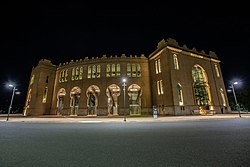You can help expand this article with text translated from the corresponding article in Spanish. (July 2025)Click [show] for important translation instructions.
|
| Real de San Carlos | |
|---|---|
Plaza de Toros Real de San Carlos | |
 The building at night. | |
 | |
| General information | |
| Type | Bullring |
| Architectural style | Moorish architecture |
| Town or city | Colonia del Sacramento |
| Country | Uruguay |
| Coordinates | 34°26′11″S57°51′55″W / 34.436527°S 57.865189°W |
| Construction started | 1909 |
| Inaugurated | January 1910, 09 |
| Renovated | 2020 |
| Cost | US$7,000,000 |
| Height | 22 metres (72 ft) |
| Dimensions | |
| Diameter | 100 metres (330 ft) |
| Design and construction | |
| Architect(s) | Josip Marković |

Plaza de toros Real de San Carlos is a former bullring in Colonia del Sacramento, Uruguay. Built in 1909 it was shortly closed after prohibition of bull fighting in 1912. After a century of abandonment, in 2021 it was finally restored and transformed into a cultural center for musical or sportive events.




